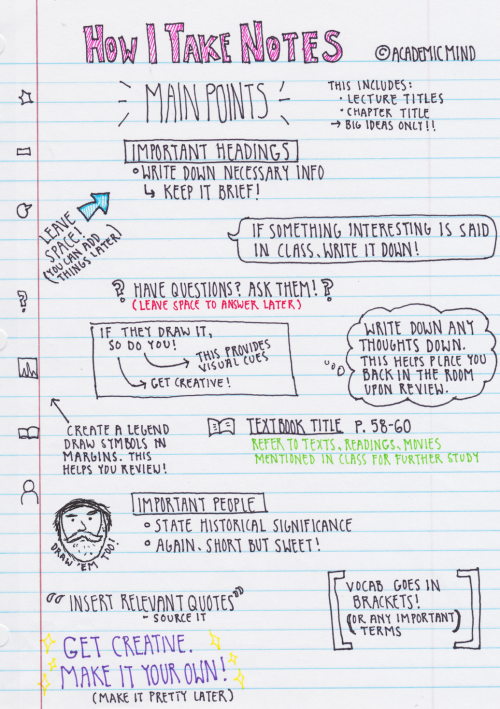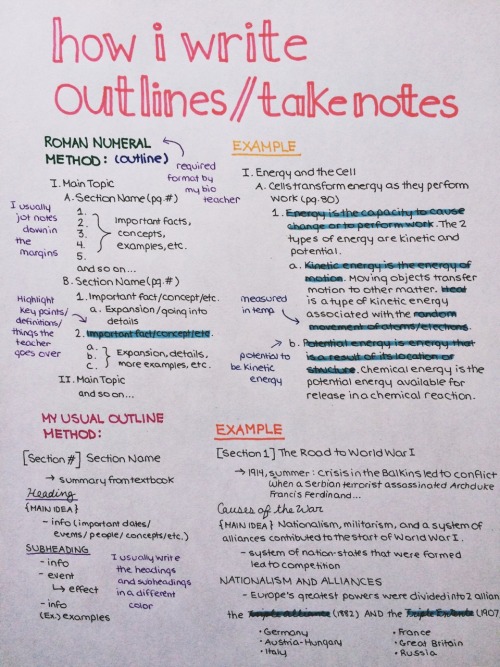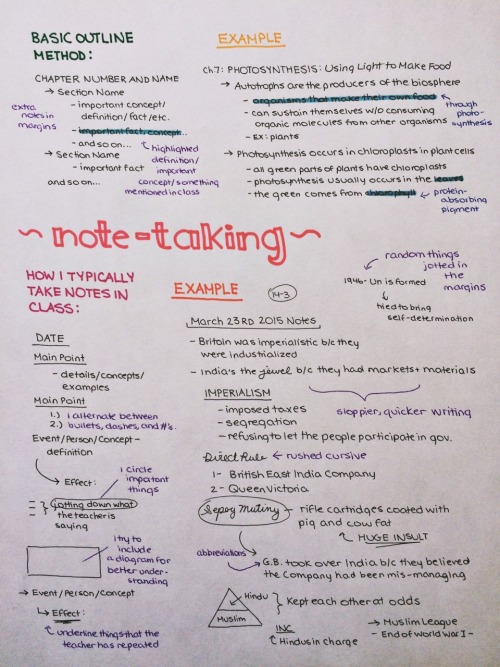Some Of You Have Requested That I Show You My Note Taking Technique. This Is In No Way A Proven Technique,

Some of you have requested that I show you my note taking technique. This is in no way a proven technique, but it really works for me and many of my professors have applauded my structure. So try it, and if you like it and it works for you, great! If not, I commend you on having a more structured system! These are my general rules when I take notes:
1. Leave space. A lot of space. While going through previous notes, whether it be right after class or a month later, I always found that I had information that I wanted to add, and cramped pages never allowed for that. Plus, it’s a bit less daunting on the eyes when there is some room between ideas. I do realize that this is not very eco-friendly, but hey!
2. Use the margins in a smart way. I have developed a “legend” of symbols to draw in the margins so that when I need a quick scan of what pages in the textbooks I referenced or vocab, I can find what I need easily. It might not seem useful on this one page, but when you have a whole 3″ binder full of notes, it’s a blessing.
3. Write on one side of the page. Again, not a eco-friendly option. However, I’m sure there are those of you (my past self included) who have wished you just had another page to write down book notes or additional thoughts without having to get a fresh paper. This solves that!
4. Make it pretty later. I know this page is visually appealing, but keep in mind that I was in my nice warm room by myself and listening to music while writing this. My notes straight out of class aren’t color coded and they definitely don’t have cute little decorations on them; just get the information down, worry about aesthetics later.
5. Put yourself in the classroom. You might think: “but I’m physically in the room what the hell are you talking about”. The concept is weird but it works. I always try everything I can to make sure I place as many visual cues in my notes as I can so that when I look back on them later I remember exactly where I was and what was happening. Are you not paying attention and thinking of food? Write it down. Did someone fart? Write it down. Placing yourself in the room is the most beneficial thing you can do for future you.
6. Keep it short. I can’t tell you how many times I freaked out when I first got to college because I was trying to write everything down. I was certain I was going to miss something. WELL HAVE I GOT NEWS FOR YOU. You aren’t going to miss anything if you keep your bullets to a minimum of one sentence. It’s proven that short phrases in your own words help memory better than full sentences that the professor gives you.
Finally, make it yours. This is a system that works for me because my brain is weird and can’t take notes the Cornell or outline way. The most important thing to learn in school is your own flow of things. Experiment, be creative! I hope I have helped those of you who aren’t traditional learners realize that there isn’t just one way to process information. If any of you have any questions or need specific examples, let me know! (I realize there is a typo on this but hey don’t worry about it) 🙈
More Posts from Marathon-notasprint and Others




04:10 PM // Hello! I made these mind maps a few days ago. I’m really proud of them considering I never made one before.
Masterpost
I’ve seen a lot of masterposts lately, but this one is the first I’ve ever done. Feel free to add to it, or make suggests for things I should add. Links will be under certain categories, so feel free to skip to the one you feel like you need. If you see something you posted and you’d like me to take it off, please let me know.
Study Tricks/Tips/Advice
1. Tips from A+ students
2. Find Your Study Style And Methods That Work For You
3. How To Study When You Don’t Feel Like It
4. Science Backed Study Tips
5. More Learning/Studying Techniques
6. Whole Page Dedicated To Studying/Organizing
7. Homework Help
8. Tips For Effective Studying
9. How To Study Like A Straight A Student
Note Taking
1. Tips For The Lazy Student
2. Info On Cornell Notes
3. Note Taking Masterpost
4. Good Note Taking Summary/Tips
Test Prep
1. How To Prepare For A Test
2. Free SAT/AP Prep Resources
Health Related
1. How To Avoid A Breakdown
2. Books Dealing With Mental Illnesses
When You Need To Read
1. How To Read Shakespeare/Old English Texts {1} {2} {3}
2. Assigned Reading Tips
3. How To Read Difficult Books
Course Specific Help- Math
1. Square Root Calculator
2. Cube Root Calculator
3. Solve Any Equation {1} {2}
4. How To Multiply Big Numbers
Course Specific Help- Chemisty
1. Chemical Equation Balancer
2. Chemistry Help Motherload (Textbooks/Resources/Help/ETC)
3. Tips For Studying Chemistry
Websites/Apps
1. Final Grades Calculator
2. Feed Hungry People And Improve Your Vocabulary At The Same Time
3. Legal Textbook Websites/Help
4. Editor That I Use For All Writing/Typing (And it’s wonderful)
5. Note Taking Website (With App)
Language Learning
1. Duolingo (I use this personally and it’s awesome)
2. German Colors List
3. Language Learning Masterpost
4. Learn 8 Chinese Words In The Cutest Way
5. Language Learning Websites
6. Tips For Self Teaching Japanese
7. Sign Language People Commonly Use
8. A Faster Way To Learn A Language
Sleep
1. Sleep Tips
2. How Long Should You Sleep For?
3. Successful Sleep Habits (Infographic)
Motivation
1. 100 Reasons To Study
2. Motivation Masterpost
3. Motivation Quotes (Via Google)
Time Management
1. Advice Graphic/Comic
2. The Pomodoro Technique
3. Time Management Masterpost
4. How To Manage Your Time Effectively
Music
1. Classical Study Playlist
2. Hit The Books Playlist {1} {2}
3. Playlists Masterpost
4. Mini Masterpost Of Playlists

hey guys, this is a masterpost requested by loveathenaa about notes and studying basically!!!
notes
taking notes from a textbook
an alternative to flashcards
pretty notes!!!!
AMAZING mind maps!!
how 2 make banners
creating better flashcards
my fav online flashcard website [there’s also an app for ur phone]
note taking methods
illustrated study methods!!!!
some more
more note taking stuff bc i just can’t get enough B-)
printables!!!!
how 2 take lecture notes
annotating!!!
studying
get motivated!!!
relax whilst studying
study playlists by me!!!!
reasons to study
my fav focusing app
how 2 study
memorisation and things
101 study tips!!!
studying biology
when ur having a bad day
productive study breaks
self-study resources
khan academy + on youtube
physics
japanese
other languages <3
more and more languages yaaas
crash course videos!!!
math help
masterpost!!!
mythology!!!!
check out 3 minute philosophy
the school of life which is my fav ever!!!!
sparknotes which is another fave
gradesaver
bbc bitesize
hope this helps u guys out a bit also if u need anything or want to request a masterpost, please message me!!! -helena xx
Note Taking Systems
The Cornell Method
The Cornell method provides a systematic format for condensing and organizing notes without laborious recopying. After writing the notes in the main space, use the left-hand space to label each idea and detail with a key word or “cue.”
Method
Rule your paper with a 2 ½ inch margin on the left leaving a six-inch area on the right in which to make notes. During class, take down information in the six-inch area. When the instructor moves to a new point, skip a few lines. After class, complete phrases and sentences as much as possible. For every significant bit of information, write a cue in the left margin. To review, cover your notes with a card, leaving the cues exposed. Say the cue out loud, then say as much as you can of the material underneath the card. When you have said as much as you can, move the card and see if what you said matches what is written. If you can say it, you know it.
Advantages
Organized and systematic for recording and reviewing notes. Easy format for pulling out major concept and ideas. Simple and efficient. Saves time and effort. “Do-it-right-in-the-first-place” system.
Disadvantages
None
When to Use
In any lecture situation.
The Outlining Method
Dash or indented outlining is usually best except for some science classes such as physics or math.
The information which is most general begins at the left with each more specific group of facts indented with spaces to the right.
The relationships between the different parts is carried out through indenting.
No numbers, letters, or Roman numerals are needed.
Method
Listening and then write in points in an organized pattern based on space indention. Place major points farthest to the left. Indent each more specific point to the right. Levels of importance will be indicated by distance away from the major point. Indention can be as simple as or as complex as labeling the indentations with Roman numerals or decimals. Markings are not necessary as space relationships will indicate the major/minor points.
Advantages
Well-organized system if done right. Outlining records content as well as relationships. It also reduces editing and is easy to review by turning main points into questions.
Disadvantages
Requires more thought in class for accurate organization. This system may not show relationships by sequence when needed. It doesn’t lend to diversity of a review attach for maximum learning and question application. This system cannot be used if the lecture is too fast.
When to Use
The outline format can be used if the lecture is presented in outline organization. This may be either deductive (regular outline) or inductive (reverse outline where minor points start building to a major point). Use this format when there is enough time in the lecture to think about and make organization decisions when they are needed. This format can be most effective when your note taking skills are super sharp and you can handle the outlining regardless of the note taking situation.
Example:
Extrasensory perception
definition: means of perceiving without use of sense organs.
three kinds
telepathy: sending messages
clairvoyance: forecasting the future
psychokinesis: perceiving events external to situation
current status
no current research to support or refute
few psychologists say impossible
door open to future
The Mapping Method
Mapping is a method that uses comprehension/concentration skills and evolves in a note taking form which relates each fact or idea to every other fact or idea. Mapping is a graphic representation of the content of a lecture. It is a method that maximizes active participation, affords immediate knowledge as to its understanding, and emphasizes critical thinking.
Advantages
This format helps you to visually track your lecture regardless of conditions. Little thinking is needed and relationships can easily be seen. It is also easy to edit your notes by adding numbers, marks, and color coding. Review will call for you to restructure thought processes which will force you to check understanding. Review by covering lines for memory drill and relationships. Main points can be written on flash or note cards and pieced together into a table or larger structure at a later date.
Disadvantages
You may not hear changes in content from major points to facts.
When to Use
Use when the lecture content is heavy and well-organized. May also be used effectively when you have a guest lecturer and have no idea how the lecture is going to be presented.
Example:

The Charting Method
If the lecture format is distinct (such as chronological), you may set up your paper by drawing columns and labeling appropriate headings in a table.
Method
Determine the categories to be covered in the lecture. Set up your paper in advance by columns headed by these categories. As you listen to the lecture, record information (words, phrases, main ideas, etc.) into the appropriate category.
Advantages
Helps you track conversation and dialogues where you would normally be confused and lose out on relevant content. Reduces amount of writing necessary. Provides easy review mechanism for both memorization of facts and study of comparisons and relationships.
Disadvantages
Few disadvantages except learning how to use the system and locating the appropriate categories. You must be able to understand what’s happening in the lecture
When to Use
Test will focus on both facts and relationships. Content is heavy and presented fast. You want to reduce the amount of time you spend editing and reviewing at test time. You want to get an overview of the whole course on one big paper sequence.
Example:

The Sentence Method
Method
Write every new thought, fact or topic on a separate line, numbering as you progress.
Advantages
Slightly more organized than the paragraph. Gets more or all of the information. Thinking to tract content is still limited.
Disadvantages
Can’t determine major/minor points from the numbered sequence. Difficult to edit without having to rewrite by clustering points which are related. Difficult to review unless editing cleans up relationship.
When to Use
Use when the lecture is somewhat organized, but heavy with content which comes fast. You can hear the different points, but you don’t know how they fit together. The instructor tends to present in point fashion, but not in grouping such as “three related points.”
Three Examples:
Example 1:
A revolution is any occurrence that affects other aspects of life, such as economic life, social life, and so forth. Therefore revolutions cause change. (See page 29 to 30 in your text about this.)
Sample Notes:
Revolution - occurrence that affects other aspects of life: e.g., econ., socl., etc. C.f. text, pp. 29-30
Example 2:
Melville did not try to represent life as it really was. The language of Ahab, Starbuck, and Ishmael, for instance, was not that of real life.
Sample Notes:
Mel didn’t repr. life as was; e.g., lang. of Ahab, etc. not of real life.
Example 3:
At first, Freud tried conventional, physical methods of treatment such as giving baths, massages, rest cures, and similar aids. But when these failed, he tried techniques of hypnosis that he had seen used by Jean-Martin Charcot. Finally, he borrowed an idea from Jean Breuer and used direct verbal communication to get an unhypnotized patient to reveal unconscious thoughts.
Sample Notes:
Freud 1st – used phys. trtment; e.g., baths, etc. This fld. 2nd – used hypnosis (fr. Charcot) Finally – used dirct vrb. commun. (fr. Breuer) - got unhynop, patnt to reveal uncons. thoughts.


How I write outlines/take notes, for those of you that were asking :)

This is how heart works <3 <3 <3
-
 zenith116 liked this · 2 months ago
zenith116 liked this · 2 months ago -
 ririleliber liked this · 1 year ago
ririleliber liked this · 1 year ago -
 werbitssft liked this · 1 year ago
werbitssft liked this · 1 year ago -
 ladychandraofthemoone reblogged this · 1 year ago
ladychandraofthemoone reblogged this · 1 year ago -
 ladychandraofthemoone liked this · 1 year ago
ladychandraofthemoone liked this · 1 year ago -
 teanster123 reblogged this · 1 year ago
teanster123 reblogged this · 1 year ago -
 craftandstudy reblogged this · 1 year ago
craftandstudy reblogged this · 1 year ago -
 teanster123 liked this · 1 year ago
teanster123 liked this · 1 year ago -
 universidad-stuff liked this · 2 years ago
universidad-stuff liked this · 2 years ago -
 firesidefandoms reblogged this · 2 years ago
firesidefandoms reblogged this · 2 years ago -
 florestnimphy liked this · 2 years ago
florestnimphy liked this · 2 years ago -
 elevatorfun reblogged this · 2 years ago
elevatorfun reblogged this · 2 years ago -
 elevatorfun liked this · 2 years ago
elevatorfun liked this · 2 years ago -
 rutvistarterpack liked this · 3 years ago
rutvistarterpack liked this · 3 years ago -
 notmonaca liked this · 3 years ago
notmonaca liked this · 3 years ago -
 prentiits liked this · 3 years ago
prentiits liked this · 3 years ago -
 strawberridrops liked this · 3 years ago
strawberridrops liked this · 3 years ago -
 merridelicious liked this · 3 years ago
merridelicious liked this · 3 years ago -
 heyitsmissalexandrealuddington liked this · 3 years ago
heyitsmissalexandrealuddington liked this · 3 years ago -
 kash-makash liked this · 3 years ago
kash-makash liked this · 3 years ago -
 savvnog liked this · 3 years ago
savvnog liked this · 3 years ago -
 neuro-coach-counselling reblogged this · 3 years ago
neuro-coach-counselling reblogged this · 3 years ago -
 aisforadventure1898 reblogged this · 3 years ago
aisforadventure1898 reblogged this · 3 years ago -
 positionsns reblogged this · 3 years ago
positionsns reblogged this · 3 years ago -
 queerhistorymajor reblogged this · 3 years ago
queerhistorymajor reblogged this · 3 years ago -
 maidtransfeminism liked this · 3 years ago
maidtransfeminism liked this · 3 years ago -
 doit4scully reblogged this · 3 years ago
doit4scully reblogged this · 3 years ago -
 z0zimus liked this · 3 years ago
z0zimus liked this · 3 years ago -
 luvgirlpower liked this · 3 years ago
luvgirlpower liked this · 3 years ago -
 akula-nox liked this · 3 years ago
akula-nox liked this · 3 years ago -
 emo-angel-xo liked this · 3 years ago
emo-angel-xo liked this · 3 years ago -
 kbww00 reblogged this · 3 years ago
kbww00 reblogged this · 3 years ago






